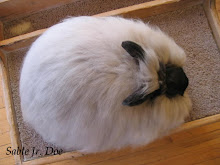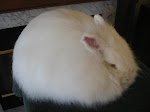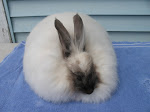Cages for domestic rabbits are important for many reasons (aside from the obvious ones). They keep rabbits safe, they keep them clean, and they clearly prevent unwanted mixing between sexes and breeds year round. For angoras a cage and the quality thereof can be more critical than for other breeds given the long coats and the need to keep them clean and undamaged during the show season. The design of floor wire preventing rabbits from having contact with their own feces also keeps diseases such as coccidiosis at bay, which tend to run rampant in populations that run outdoors or on the ground in a colony situation.
The best cages are made of galvanized-after wire, and the top and sides are constructed of a 1 X 2 inch mesh. Floor wire should be laid so that the 1/2 X 1 inch mesh is smoothest on the top (if you look at the wire you can see which side should be flipped upward to prevent strain on the rabbits' feet). Also, a thing called baby-saver wire is available on cages built for does, which decreases in mesh size from top to bottom so kits do not fall or crawl out of cages. Baby saver wire should almost be considered critical for breeding cages.
Many people inquire about urine guards, which are often included automatically with kit cages. The function of a urine guard is to prevent rabbits from spraying urine out the lower half of the cage onto a neighbor, but I have found that more often than not these backfire because rabbits tend to back up to them and spray their own coats when they urinate. Many years ago I removed the guards from all my cages and have had no problems with backspraying since.
In terms of size, the size of a cage will be determined by the breed you raise. In the case of angoras, the size of a coat may also determine the size of a cage---sometimes far and above the weight of the animal itself. The English Angora is the smallest of the angora breeds at 5-7 lbs, but it is also known to possess the largest coat (particularly in show lines). For this reason, a 30 X 36 inch cage is desirable for bucks and does of this breed. For the French, Satin, and Giant angoras a 30 X 36 inch is warranted as well due to the adult size and weight of these breeds (including their coats). Some people choose to house large angoras in 30 X 30 inch cages, but it must be remembered that space is essential for adequate exercise, for breeding, and also for keeping the rabbitry cool in summer when more space between rabbits means greater air circulation. A smaller cage (such as a 30 X 30) is useful for juniors or when weaning litters, but it should not be used very often for any angora in full coat.
Another thing to consider when determining size of cages is breeding. A doe with a litter will absolutely require a 30 X 36 inch space to accomodate a nestbox or litter of any size, particularly as the babies grow. It is not uncommon for the larger breeds (particularly French and Satin) to have litters of 8-10 or more, and it is critical that the cage have space to accomodate a litter of this size through the weaning stage. Doe cages that are too small will result in overcrowding, unsanitary conditions, and also---in the warmer months----an increased likelihood that a lack of air circulation will result in dropped ears on babies, rendering them unshowable. For years I considered 30 X 36 to be the standard for doe cages in my own rabbitry, but in the future I intend to extend those dimensions to 30 X 48 in order to accomodate the largest litters.
Another consideration when deciding what cage design/size to use is the height and reach of the manager. A short person with shorter arms may want to design a cage that is long but shallow in order to easily reach the back. It is appropriate to decrease the width of a cage (as long as it is still big enough to accomodate a nestbox), but loss in space has to be compensated for with greater length in order to give a large rabbit room to move and turn comfortably. The height of a standard angora cage should be 18 inches.
Feed dishes may come into play when designing a cage if you wish to use J-feeders that are mounted on a cage by cutting through the sidewire. If you intend to permanently alter your cages in this way then you must be certain that the feeders you use are wide enough for an angora (with furnishings) to get it's head inside them and consume the feed right down to the bottom without grinding fur or wool off. You must also be sure that you have modifications in place to accomodate litters, which will require unlimited feed and may also need a larger feeder or additional dishes inside the cage.
More again next time about various cage setups and the advantages and disadvantages of each. Hope everyone is having a wonderful fall breeding season so far!!:-)
























7 comments:
Waiting patiently for part 2! :-)
Waiting patiently for part 2. :-)
Waiting patiently for part 2. :-)
Waiting patiently for part 2. :-)
Waiting patiently for part 2. :-)
Sorry about that, it seemed that it wasn't accepting the comments, because the comment field went blank and new words came up to 'prove I'm not a robot'.
Merry Christmas!
Also checking in - would love to read more :)
Great Blog and such a wealth of info. Thank you Amy!
Post a Comment